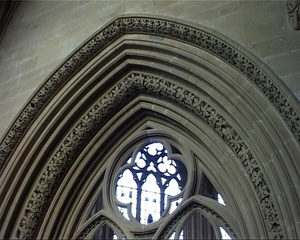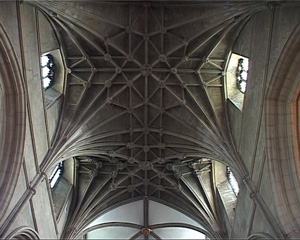40 Romanesque and Gothic Architecture
Romanesque Architecture
The name gives it away–Romanesque architecture is based on Roman architectural elements. It is the rounded Roman arch that is the literal basis for structures built in this style.
All through the regions that were part of the ancient Roman Empire are ruins of Roman aqueducts and buildings, most of them exhibiting arches as part of the architecture. (You may make the etymological leap that the two words are related, but the Oxford English Dictionary shows arch as coming from Latin arcus, which defines the shape, while arch-as in architect, archbishop and archenemy-comes from Greek arkhos, meaning chief. Tekton means builder.)
The remains of Roman civilization are seen all over the continent of Europe, and legends of the great empire would have been passed down through generations. So in the ninth century when Emperor Charlemagne wanted to unite his empire and validate his reign, he began building churches in the Roman style–particularly the style of Christian Rome in the days of Constantine, the first Christian Roman emperor.
After a gap of around two hundred years with no large building projects, the architects of Charlemagne’s day looked to the arched, or arcaded, system seen in Christian Roman edifices as a model. It is a logical system of stresses and buttressing, which was fairly easily engineered for large structures, and it began to be used in gatehouses, chapels, and churches in Europe. These early examples may be referred to as pre-Romanesque because, after a brief spurt of growth, the development of architecture again lapsed. As a body of knowledge was eventually re-developed, buildings became larger and more imposing. Examples of Romanesque cathedrals from the Middle Ages (roughly 1000-1200) are solid, massive, impressive churches that are often still the largest structure in many towns.

The arches that define the naves of these churches are well modulated and geometrically logical – with one look you can see the repeating shapes, and proportions that make sense for an immense and weighty structure. There is a large arcade on the ground level made up of bulky piers or columns. The piers may have been filled with rubble rather than being solid, carved stone. Above this arcade is a second level of smaller arches, often in pairs with a column between the two. The next higher level was again proportionately smaller, creating a rational diminution of structural elements as the mass of the building is reduced.

The decoration is often quite simple, using geometric shapes rather than floral or curvilinear patterns. Common shapes used include squares, lozenges, chevrons, and zigzag patterns and shapes. Plain circles were also used, which echoed the half-circle shape of the ubiquitous arches.
Early Romanesque ceilings and roofs were often made of wood, as if the architects had not quite understood how to span the two sides of the building using stone, which created outward thrust and stresses on the side walls. This development, of course, didn’t take long to manifest, and led from barrel vaulting (simple, semicircular roof vaults) to cross vaulting, which became ever more adventurous and ornate in the Gothic.

The third and fourth images on this page are from Gloucester Cathedral; all other images depict Southwell Minster.
Gothic Architecture
Forget the association of the word “Gothic” to haunted houses, dark music, or ghostly pale people wearing black nail polish. The original Gothic style was actually developed to bring sunshine into people’s lives and especially into their churches. To get past the accrued definitions of the centuries, it’s best to go back to the very start of the word Gothic, and to the style that bears the name.
The Goths were a so-called barbaric tribe who held power in various regions of Europe, between the collapse of the Roman Empire and the establishment of the Holy Roman Empire (so, from roughly the fifth to the eighth century). They were not renowned for great achievements in architecture. As with many art historical terms, “Gothic” came to be applied to a certain architectural style after the fact.
The style represented giant steps away from the previous, relatively basic building systems that had prevailed. The Gothic grew out of the Romanesque architectural style, when both prosperity and peace allowed for several centuries of cultural development and great building schemes. From roughly 1000 to 1400, several significant cathedrals and churches were built, particularly in Britain and France, offering architects and masons a chance to work out ever more complex problems and daring designs.

The most fundamental element of the Gothic style of architecture is the pointed arch, which was likely borrowed from Islamic architecture that would have been seen in Spain at this time. The pointed arch relieved some of the thrust, and therefore, the stress on other structural elements. It then became possible to reduce the size of the columns or piers that supported the arch.
So, rather than having massive, drum-like columns as in the Romanesque churches, the new columns could be more slender. This slimness was repeated in the upper levels of the nave, so that the gallery and clerestory would not seem to overpower the lower arcade. In fact, the column basically continued all the way to the roof, and became part of the vault.

In the vault, the pointed arch could be seen in three dimensions where the ribbed vaulting met in the center of the ceiling of each bay. This ribbed vaulting is another distinguishing feature of Gothic architecture. However, it should be noted that prototypes for the pointed arches and ribbed vaulting were seen first in late-Romanesque buildings.

The new understanding of architecture and design led to more fantastic examples of vaulting and ornamentation, and the Early Gothic or Lancet style (from the twelfth and thirteenth centuries) developed into the Decorated or Rayonnant Gothic (roughly fourteenth century). The ornate stonework that held the windows–called tracery–became more florid, and other stonework even more exuberant.
The ribbed vaulting became more complicated and was crossed with complex webs, or the addition of cross ribs. Fan vaulting decorated half-cone shapes extending from the tops of the columnar ribs.

The slender columns and lighter systems of thrust allowed for larger windows and more light. The windows, tracery, carvings, and ribs make up a dizzying display of decoration that one encounters in a Gothic church. In late Gothic buildings, almost every surface is decorated. Although such a building as a whole is ordered and coherent, the profusion of shapes and patterns can make a sense of order difficult to discern at first glance.

After the great flowering of Gothic style, tastes again shifted back to the neat, straight lines and rational geometry of the Classical era. It was in the Renaissance that the name Gothic came to be applied to this medieval style that seemed vulgar to Renaissance sensibilities. It is still the term we use today, though hopefully without the implied insult, which negates the amazing leaps of imagination and engineering that were required to build such edifices.


